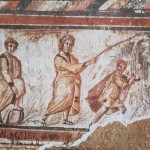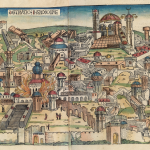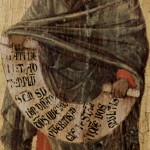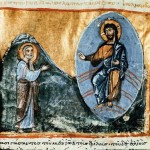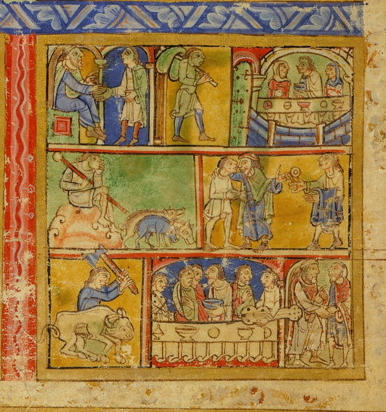
What It’s About: This is the story of the first passover celebrated after leaving Egypt, in the land of Canaan. It’s a sparsely narrated affair, with few details, but it marks a kind of symbolic turning point in the story. Provisions of manna cease at that moment, and the Israelites began to live off the land.
What It’s Really About: This story helps to make a bridge between two major parts of the story of Israel. One part–the captivity in Egypt and the dramatic exodus from there–lies in the past. Another story–the establishment of a kingdom and a society in a new place–lies in the future. Interestingly, it is food that symbolizes these different parts of the narrative. Manna ceases at this passover, and from that point forward crops (parched grain and unleavened cakes) provide sustenance for the people. This is a kind of culinary argument for establishment, permanency, and self-sufficiency; the people can live there on their own. We can see the seeds of the future in this brief passage.
What It’s Not About: Whose grain was it? From whose fields did the produce come? On the one hand, the story of the exodus out of Egypt is a story of liberation and divine providence. On the other hand, the story of the entry into Canaan, especially as it is told in Joshua, is a story of a new kind of oppression and violence: of the Israelites against the native Canaanites. There is an inherent tension in any story like this one, that celebrates Israel’s entry into the land and establishment there, because there were people there before the Israelites. There is no blank slate, geopolitically, and one people’s exodus is another people’s invasion. Did the Israelites plant this grain, on which they began to subsist at the passover narrated in this passage? Or were these fields seized from others?
Maybe You Should Think About: Think about the kinds of claims we make with our stories. Stories of triumph and liberation are not always neutral; they can inflict violence and harm upon others. How, then, can we celebrate God’s providence and God’s care when there are others who do not seem to share it, and who even seem to suffer because of our successes? This is a deeply theological problem, and sometimes narrative is a good way to explore those kinds of problems.
What It’s About: This passage is about transformation. It is about changes in perspective and being made new. And ultimately, it is about reconciliation between God and the world and between God and us as God’s people.
What It’s Really About: This is from Paul’s famously messy second letter to the Corinthians, which is actually probably several letters edited together. Because it is made up of different letters written at different times and in different circumstances, parts of 2 Corinthians are angry, parts are wounded and tender, and parts are unbelievably positive. This passage is of that third part; Paul here is in one of his trademark flourishes, exhorting his readers to think differently and be differently. At stake are three major claims: that we ought to experience a shift in our perspective (such that we know Christ in a different way), that we ourselves ought to be transformed, and that God was in Christ reconciling God’s self to the world. These are all bound up together for Paul; you can’t accept one without accepting them all. The work of Christ, Paul thinks, has changed everything, absolutely, so that the very being of the world has shifted in a perceptible way. We have to be a part of that transformation.
What It’s Not About: It’s always striking how contemporary Christianity reads individualism into the New Testament where there isn’t much individualism to be found. This passage is a good example. Read verse 19 closely, and ask what is being reconciled. It isn’t me, or you, or the guy on the bus. It’s the world. Christian theology has failed to grasp, to a startling degree, how Paul thought that God was in the business of redeeming the world, not individuals. Paul understood God to be working on the scale of ethnic groups, provinces, and continents, not on the scale of individuals. This is why, at the end of his career, he wanted so desperately to go to Spain, which was then considered the end of the world. He had planted churches in Greece and Asia Minor, and those seed churches were enough; there was no sense that he needed to engage in “retail” conversions of individuals. He just needed, and God just needed, someone in all parts of the world to make it so that the world was being redeemed.
Maybe You Should Think About: What does it mean if God is in the business of reconciling the world to God, and not just us individually? How do our responsibilities change? How does our religion change?
What It’s About: This is the story of the prodigal son, one of the most famous stories in the New Testament. It’s the tale of an heir who got his inheritance too soon, squandered it all, made his way back home in shame, and was accepted with open arms. It’s also, we should note, the story of a father who loved rather than judged, and who embraced his lost son rather than rejected him. And–finally–it is the story of a good son, one who did everything right and was faithful the whole time, being overshadowed by the dramatic redemption story of his brother.
What It’s Really About: The lectionary has us skip verses 4-11a, but you should consider reading them anyway. That’s because Luke 15 contains three parables that are meant to be read and understood together. They are all stories of lost things: a lost sheep, a lost coin, and a lost son. Luke was not stupid, and he put these stories together for a reason: because they interpret one another. Without the stories of the lost coin and the lost sheep, the story of the prodigal son isn’t as powerful, and it doesn’t make as much sense. The structure of lostness/foundness is laid out by the other two, and it helps to frame our hearing of the story of the son, having heard the other two first.
What It’s Not About: I’ve been surprised, over the years, at how many people identify with the elder son in this story–the one who did everything right. There is a sense of resentment among people who have lived life the “right way,” only to see others rewarded out of stories of fall and redemption. It seems that for a lot of people this story can function as a map of family dynamics, and it can be painful that way. But it can also function as a map of early Christianity, and the kinds of resentment that Jews must have felt at the inclusion of gentiles (who were stereotyped as licentious, drunkards, promiscuous, etc, in the same way the younger son is described here). That Jesus is telling this story to fellow Jews, in the context of explaining his acceptance of sinners, probably points in that direction.
Maybe You Should Think About: The challenge with a story like this is that everyone already knows it. How can you help people to hear this anew? We’ve all heard the story of the prodigal son, but how can we hear it differently?

